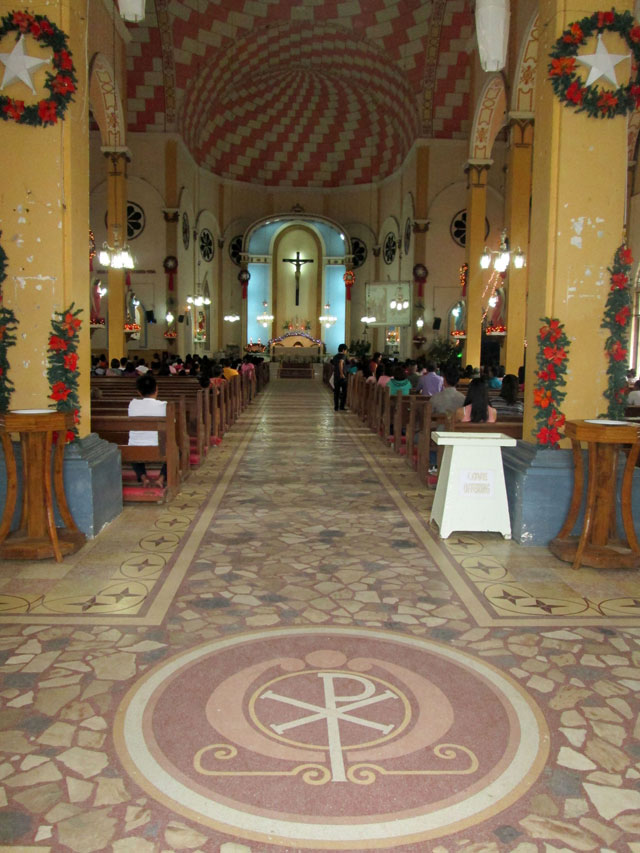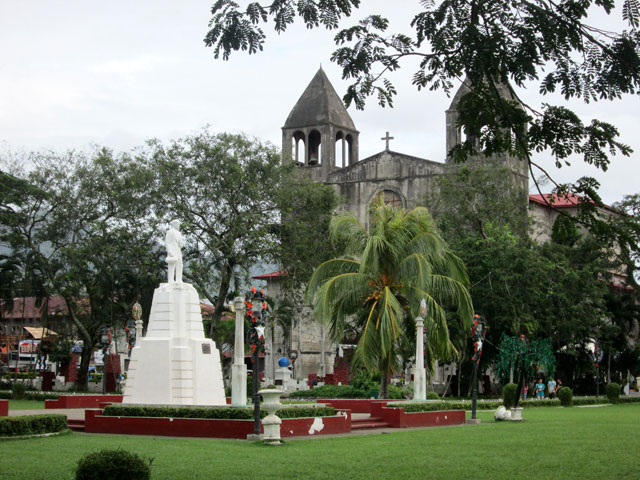SUMMARY
This is AI generated summarization, which may have errors. For context, always refer to the full article.
“I die without seeing the dawn brighten over my native land. You who have it to see, welcome it – and forget not those who have fallen during the night.” – From Dr. Jose P. Rizal’s Noli mi Tangere

DAPITAN CITY, Philippines – If Dr. Jose P. Rizal were alive today and ran for mayor here next year, will he win?
A lot of Dapitanons say no. “He will surely lose because I know that he will not give up his ideals over a seat in the government,” says 68 -year-old Thaddeus T. Hamoy, grandson of Rizal’s business partner Mariano Hamoy here.
Dapitan is a microcosm of the political system the Philippines have today, where massive vote selling, intimidation, patronage and sometimes killings often determine who wins rather than personal record, competence, platform of government and dedication to service.
Gabriel Cad, curator of the Rizal Shrine (an estate at the outskirt of Dapitan that Rizal bought after winning lottery), adds that with Rizal’s strong ardor to patriotism and decency, he will easily lose because he will never play with the present political culture.
“Before, to choose leaders was to choose between bad and good. Later, it was choosing the lesser evil. Now, the greater evil usually wins,” Cad says.
“And if Rizal were alive today, either he will shoot all the unscrupulous politicians or he will not wait for a firing squad, and will shoot himself to death out of frustration,” laments Hamoy.
Celebrity

Rizal spent perhaps the best moments of his life in Dapitan, while in exile from June 17, 1892 to July 31, 1896. It was in Dapitan where he did his best to mold an ideal society – educated, disciplined and compassionate with its patriotic inhabitants having the right to choose their religion and leaders.
Aside from teaching, attending to the sick and doing engineering works, Rizal also taught Dapitanons love of country and respect to others without necessarily being subservient to the abuses of others or those in authority.
“According to my grandfather, Rizal would take off his hat and greet anybody he meets on the street,” Hamoy recalls. “There was a time when Rizal was asked why he was greeting those who were below his status, and he answered he did it on purpose so they will learn how to respect others.”
They way he lived and his teachings made Rizal a celebrity in Dapitan. They admired him of being so respectful to the dignity and the rights of even those who have less in society, and showed to them that if necessary they should fight for it.
“There was a French businessman, Jean Lardet, who was berating his Dapitanon laborer,” Hamoy recollects his grandfather’s stories, “Rizal intervened and told Lardet to apologize to the laborer, telling him that his laborer has also dignity to be respected.”
Lardet refused, and instead challenged Rizal to a duel. They agreed to use pistols and would meet at the Dapitan beach the following morning. Upon hearing about the duel, Capitan Ricardo Carnicero – then Spanish politico-military governor of Dapitan and warden of Rizal during his exile – appealed to Lardet to just apologize because he would surely lose to Rizal who was a superior marksman.
Lardet did not show up at the Dapitan beach the following morning, and eventually sent a letter of apology and promised to respect the dignity of his Dapitanon laborers.
Paradigm shift

“A lot of Dapitanons imitated Rizal’s ways,” Hamoy says. “When Rizal left, his students did good with their lives, and some became leaders. Jose Aseniero became governor. Jose Dalman became mayor of Lubongan (now Municipality of Katipunan, Zamboanga del Norte), and was succeeded by another student of Rizal, Fernando Eguia.”
Hamoy recalls there was even a time when Rizal’s influence has made Dapitan a model of political maturity among its neighboring communities.
“Many decades ago, even relatives were divided by political party lines, but it stops there. After elections we’re united again. For whatever political party we belong, we still meet together during weddings, or baptism or if somebody dies,” Hamoy explains.
He adds that before, there was no vote buying or selling in Dapitan, there were no intimidations or harassments and nobody would even attempt to bribe government officials conducting the elections.
“But more or less two decades ago, politics changed everything and we have shifted away from Rizal’s ideals,” Hamoy observes. “Unfortunately, patriotism, love of country, honesty and integrity that Rizal wanted Dapitanons, and all Filipinos, to have are gone.”
Cad adds that most of the politicians now buy votes or cheat to win. “When asked why they sell their votes, a lot of voters would say they accept politicians’ money because it no longer matter to them whoever wins, the government couldn’t liberate them from poverty anyway,” he reveals.
Renewal

Is there still hope?
“There is still hope,” Hamoy answers. “With today’s 116th commemoration of Rizal’s martyrdom, Dapitanons and all Filipinos should continue to remember that relatively short, well-dressed and refined gentleman not by the way he died in Luneta, but by the way he lived in Dapitan.”
Hamoy says that if adults cannot do it, there is still hope among the young. “Schools all over the Philippines should continue education about the teachings of Rizal. Not just to pass the course, but to imitate the ways of our national hero.”
A local government employee, Maria Victoria Bangcua, echoes Hamoy’s wishes. “We are to be blamed if our young today will drift farther from the ideal society that Rizal almost successfully built in Dapitan. I am a believer of the idea that every generation is responsible to the next.”
And it makes sense that Dapitanons will spearhead among Filipinos in the renewal towards a society that Rizal wanted to build, and finally the country that our national hero wanted to have.
For now, Hamoy says, Dapitan is becoming more popular as the place of a famous five-star beach resort rather than the place of Rizal’s exile. But he hopes that soon he will hear Filipino tourists visit Rizal’s Shrine and comment, “so, you also have a fine beach resort,” rather than Filipino tourists checking in at Dakak and comment, “so, Rizal spent four years of his life here.”
Inday Torak, Rizal’s fling in Dapitan
DAPITAN CITY – History books say that it was in this remote place of Dr. Jose P. Rizal’s exile from June 17, 1892 to July 31, 1896 that he met and fell in love with Irish Josephine Bracken. But known only to Dapitanons, our national hero had also another fling here – a homey young girl named Pastora Nececsario, or known here as “Inday1 Torak.”
A few months after his four-year exile started with his arrival here on June 17, 1892, Rizal and his Spanish warden Capitan Ricardo Carnicero, who was also Dapitan’s politico-military governor, transferred to the house of Don Ramon Carreon while Carnicero’s home near the Catholic Church was undergoing renovation.
It was during that time when Rizal saw Inday Torak, the neighbor of Don Carreon in nearby village called “Balikasan2 “.
“The Senor Rizal-Inday Torak love affair is like that of Sir Chief-Maya plot, there never was a formal courtship, just MU or mutual understanding or mag-un. But the grapevine that followed the two persisted in Dapitan,” said Gabriel Cad, curator of the Rizal Shrine here.
In fact, Cad’s grandfather, Florentino A. Cad (1901-1991) wrote in his undated memoir: “There was a time when I was so stricken with an overwhelming curiosity as to Rizal’s feelings towards our women in Dapitan that I spent a couple of days roaming around town just to (get information) about the old and (persistent) rumor that Pastora Necessario had been the object of attention and affection of Rizal.”
Cad the grandfather, according to Cad the grandson, eventually ended his interviews with Inday Torak.
In his memoir, Cad the grandfather said, “Even though (Pastora Necesario) was already past middle age, she still (had) traces of rare beauty and charm. She must be one of the most popular belles in our town during her heyday.”
Inday Torak narrated to Cad the grandfather that she was still in her early teens when she first saw Capitan Cernicero’s groovy prisoner. She said that from the window of Don Ramon’s house facing their house, Rizal would always take a peek at her while weaving at her loom. Inday Torak usually weaves at her loom below their house. In early Dapitan, houses were built with high posts so the space below can be used as the parking area of “karomata” (two-wheel cart pulled by a carabao), a place where they could make furniture, a place for looms or where they could tie their livestock when it rains.
One day the surprise of her life came, Inday Torak told Cad the grandfather, when that strange but handsome face she used to see at her neighbor’s window suddenly showed up on top of a luscious and well-carved lean body.
Rizal introduced himself first to the parents, and then to Inday Torak. Then our national hero gave her a six-inch statuette of a girl in the act of weaving, which shocked the Dapitanon leading lady because she saw herself in the image made of clay known here as “pekpekon.” “Rizal became a regular visitor of the Necesario household,” Cad the grandfather said in his memoir. “According to (Inday) Torak, (Rizal) never spoke about his personal feelings for her although she would always see admiration and affection for her in his eyes.”
Inday Torak also revealed that Rizal gave her several poems, which unfortunately she did not understand because it was written in Spanish. And Rizal did not tell Inday Torak what the poem meant. But in at least one of his letters to his sister Trinidad,Rizal revealed that she liked Inday Torak for being homey yet had strong social concern.
In a letter to Trinidad believed to be written in 1894, Rizal said: “El Primo de Pastora ya esta y bien.” (The first thing from Pastora is doing good to the people.) After Rizal transferred to Talisay, an estate one kilometer away from the town center, he still visited Inday Torak, perhaps until the arrival of Bracken, who accompanied her stepfather Senor Taufer see Rizal for an eye consultation.
Bracken eventually became Rizal’s mistress, and they lived together in Talisay. “I asked (Inday) Torak pointedly whether she loved Rizal,” Cad the grandfather said in his memoir. “She (answered) she could not understand her feelings at that time, but she was (sure) that she respected and admired him very much because of his gentle and charming manners and his unfailing courtesy.”
And Cad the grandfather, too, admired the ideals of Rizal that he wrote in his memoir: “Looking back, it sometimes crosses my mind that if he had stayed longer or if Josephine Bracken did not appear…(Rizal might have been more successful) in Dapitan, and he would have decided to make this place of his exile his permanent retreat.”
1 Cebuano term of endearment to women.
2 Balikasan means” to curse.” The village still exists today. It is a former cemetery of the Subanens and believed to be haunted by ghosts. Dapitanons who pass by this village usually mutter obscene curses to drive away the spirits.
– Rappler.com
Add a comment
How does this make you feel?
There are no comments yet. Add your comment to start the conversation.